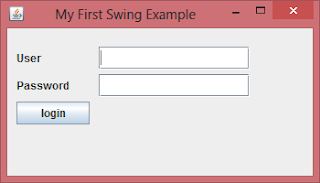Java
Swing
Java Swing is a
part of Java Foundation Classes (JFC) that is used to create window-based applications. It is built on the top of AWT
(Abstract Windowing Toolkit) API and entirely written in java.
Unlike
AWT, Java Swing provides platform-independent and lightweight components.
The
javax.swing package provides classes for java swing API such as JButton,
JTextField, JTextArea, JRadioButton, JCheckbox, JMenu, JColorChooser etc.
Java Swing
Examples
There
are two ways to create a frame:
- By creating the object of Frame
class (association)
- By extending Frame class
(inheritance)
Example:-
import javax.swing.*;
public class FirstSwingExample {
public static void main(String[] args) {
JFrame f=new JFrame();//creating instance of JFrame
JButton b=new JButton("click");//creating instance of JButton
b.setBounds(130,100,100, 40);//x axis, y axis, width, height
f.add(b);//adding button in JFrame
f.setSize(400,500);//400 width and 500 height
f.setLayout(null);//using no layout managers
f.setVisible(true);//making the frame visible
}
}
 |
Fig: Java Swing |







No comments:
Post a Comment